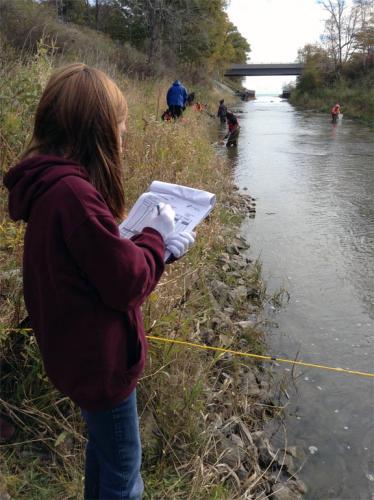Citizen science enhances place-based education opportunity – Part 2
Teachers can explore place-based education and enhance student learning opportunities through many citizen science opportunities open to school involvement.

As the school year resumes, teachers might consider the many citizen science partners and projects as opportunities (see Part 1) to promote hands-on learning with students. These opportunities afford students with a chance to contribute to research, monitoring, and a better understanding of our valuable Great Lakes and natural resources. Many of these established citizen science efforts are teacher-friendly, and designed with simple protocols by which to register, implement, and report research and findings.
Citizen science involvement lends itself as a great launching point for schools and teachers looking to leap deliberately and purposefully into place-based education stewardship with their students. Place-based education, as supported by the Great Lakes Fishery Trust’s Great Lakes Stewardship Initiative (GLSI), offers a framework by which teachers can engage students in citizen science learning activities, making a difference in their communities by benefiting their local environments.
Education leaders across Michigan, partnering through the GLSI network, have considered a few ways in which place-based education principles and practices can help make citizen science experiences more engaging to students and relevant in their community. They offer the following:
- How can teachers and students choose among the wide variety of citizen science options? A place-based education perspective helps frame this question in the context of the local environmental and community needs. Students can be part of identifying and describing the local needs and opportunities.
- Student voice is key – establish a well-defined role for students in exploring, selecting or designing, and delivering citizen science projects locally. A recent National Science Foundation-supported project resulted in the development of some well known place- or community-based education resources and curriculum. In 2012, Jon Yoder (a former teacher) authored, Connecting Classrooms to the Community, which includes examples and lessons designed to get students involved in exploring issues and selecting projects relevent to their local place and community.
- Start simple and grow into opportunities! Established ‘cookie cutter’ programs can be a great way to jump in and get started with citizen science partners and projects that are already designed and ready to implement. These can lead to future in-depth studies and opportunities. Alpena High School students started simply with the established Adopt-a-Beach clean-up, coordinated with Alliance for the Great Lakes. Students’ concern about plastic pollution resulted in the incorporation of a student initiated microplastic study on Lake Huron with leading Great Lakes researchers in their chemistry class.
- Don’t be trapped by ‘canned’ programs. Recognize local, organically developed projects that help guide citizen science experiences. Alcona County youth are
 protecting their parks with Michigan DNR and Michigan Natural Features Inventory by identifying invasive species while mapping potential wetland habitats for the endangered Hines Emerald Dragonfly at Negwegon State Park.
protecting their parks with Michigan DNR and Michigan Natural Features Inventory by identifying invasive species while mapping potential wetland habitats for the endangered Hines Emerald Dragonfly at Negwegon State Park. - Look to your community conservation partners for potential projects. Identify local investments within the community, such as conservation habitat restoration projects. Citizen science projects may offer opportunities for students to help collect data in evaluating the effectiveness of these habitat improvement projects.
- Seek out the educational values in the data your students have collected locally. Typically, you might report your findings to a researcher or organizational partner leading the citizen science project; but, science learning need not end there. Supporting student analysis and communication about the data they collect is a great way to immerse students in the process of science. This may also enhance inquiry-based learning opportunities about locally relevant natural resource topics and issues.
- Gain a global perspective through your local findings. Students may focus on a project, locally, or through statewide and Great Lakes regional partners and programs – such as Great Lakes FieldScope. Through FieldScope, students can enter their data and share this with others across the nation and the world. Connecting stewardship efforts even among schools locally, such as through the Northeast Michigan Youth Watershed Summit, is a great opportunity to communicate about citizen science experiences and local impacts.
- Raise interest and awareness about Great Lakes issues through public outreach – share your project and findings with your community. Often, through these projects, students help raise awareness about the conservation issues to which they are contributing. Community members and media often take note when students get involved. This offers a great opportunity for youth to speak about topics or issues important to them. Students have an opportunity to experience public policy first-hand by sharing their findings with decision makers.
Citizen science opportunities are a great way to involve schools, teachers, and students in science and the study of Michigan’s Great Lakes and natural resources. Place-based education offers a framework by which students can contribute to these real-world and meaningful environmental stewardship efforts through their learning and leadership at school.



 Print
Print Email
Email


